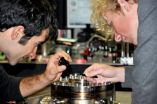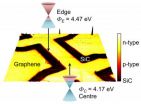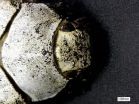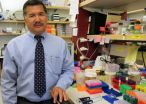(Press-News.org) Laser physicists have found a way to make atomic-force microscope probes 20 times more sensitive and capable of detecting forces as small as the weight of an individual virus.
The technique, developed by researchers at The Australian National University (ANU), hinges on using laser beams to cool a nanowire probe to minus 265 degrees Celsius.
"The level of sensitivity achieved after cooling is accurate enough for us to sense the weight of a large virus that is 100 billion times lighter than a mosquito," said Dr Ben Buchler from the ANU Research School of Physics and Engineering.
The development could be used to improve the resolution of atomic-force microscopes, which are the state-of-the-art tool for measuring nanoscopic structures and the tiny forces between molecules.
Atomic force microscopes achieve extraordinarily sensitivity measurements of microscopic features by scanning a wire probe over a surface.
However, the probes, around 500 times finer than a human hair, are prone to vibration.
"At room temperature the probe vibrates, just because it is warm, and this can make your measurements noisy," said Professor Ping Koy Lam, a co-author of the research that is published in Nature Communications.
"We can stop this motion by shining lasers at the probe," he said.
The force sensor used by the ANU team was a 200 nm-wide silver gallium nanowire coated with gold.
"The laser makes the probe warp and move due to heat. But we have learned to control this warping effect and were able to use the effect to counter the thermal vibration of the probe," said Giovanni Guccione, a PhD student on the team.
However, the probe cannot be used while the laser is on as the laser effect overwhelms the sensitive probe. So the laser has to be turned off and any measurements quickly made before the probe heats up within a few milliseconds. By making measurements over a number of cycles of heating and cooling, an accurate value can be found.
"We now understand this cooling effect really well," says PhD student Harry Slatyer. "With clever data processing we might be able to improve the sensitivity, and even eliminate the need for a cooling laser."
INFORMATION:
Laser makes microscopes way cooler
Cooling a nanowire probe with a laser could lead to substantial improvements in the sensitivity of atomic force probe microscopes
2014-08-15
ELSE PRESS RELEASES FROM THIS DATE:
Adipose-derived stem cells and nerve regeneration
2014-08-15
Stem cell researchers at the Blond McIndoe Laboratory, University of Manchester, UK, led by Dr Adam Reid, present a review of the current literature on the suitability of adipose-derived stem cells in peripheral nerve repair.
Injuries to peripheral nerves are common and cause life-changing problems for patients alongside high social and health care costs for society. Current clinical treatment relies on sacrificing a nerve from elsewhere in the body to provide a nerve graft at the injury site, but much work has been done to develop a bioengineered nerve graft that would ...
Politicians need to address transport taboos, not just new technology, to meet carbon targets
2014-08-15
Transport accounts for 30% of CO2 emissions in the EU, with emissions rising 36% between 1990 and 2007. The research, carried out by Lund University and the University of Surrey a found a need to dissect the widely-held view that new technologies, such as biofuel and improved aircraft design, will result in carbon reduction targets being met.
In the paper, researchers highlight the fact that policy makers are turning to the perceived benefits of such technologies to drive decarbonisation policy, despite contrary evidence. They argue that in order to cut damaging carbon ...
On the edge of graphene
2014-08-15
Researchers at the National Physical Laboratory (NPL) have discovered that the conductivity at the edges of graphene devices is different to that of the central material.
Local scanning electrical techniques were used to examine the local nanoscale electronic properties of epitaxial graphene, in particular the differences between the edges and central parts of graphene Hall bar devices. The research was published in Scientific Reports, an open access publication from Nature Publishing Group.
The researchers found that the central part of the graphene channel demonstrated ...
TUM researchers develop defense against cyberattacks
2014-08-15
Port scanners are programs that search the Internet for systems that exhibit potential vulnerabilities. According to the report published today by journalists at Heise Online, Hacienda is one such port scanning program. The report says that this program is being put into service by the "Five Eyes," a federation of the secret services of the USA, Canada, the UK, Australia and New Zealand. "The goal is to identify as many servers as possible in other countries that can be remotely controlled," explains Dr. Christian Grothoff, Emmy Noether research group leader at the TUM ...
Experts close to perfect in determining truth in interrogations using active question methods
2014-08-15
Washington, DC (August 12, 2014) – Determining deception is a tool of the trade for law enforcement. The Good Cop/Bad Cop routine is etched in our minds as an effective method of finding out the truth. But prior research has shown that lie detecting is a 50/50 shot for experts and non-experts alike. So what exactly can we do to find out the truth? A recent study published in Human Communication Research by researchers at Korea University, Michigan State University, and Texas State University - San Marcos found that using active questioning of individuals yielded near-perfect ...
The beetle's white album
2014-08-15
The physical properties of the ultra-white scales on certain species of beetle could be used to make whiter paper, plastics and paints, while using far less material than is used in current manufacturing methods.
The Cyphochilus beetle, which is native to South-East Asia, is whiter than paper, thanks to ultra-thin scales which cover its body. A new investigation of the optical properties of these scales has shown that they are able to scatter light more efficiently than any other biological tissue known, which is how they are able to achieve such a bright whiteness. ...
Personal, public costs of scientific misconduct calculated
2014-08-15
Much has been assumed about the private and public damage of scientific misconduct. Yet few have tried to measure the costs to perpetrators and to society.
A recent study calculated some of the career impacts, as well as federal funding wasted, when biomedical research papers are retracted. The results appear in the Aug. 15 issue of the journal eLife.
In questioning common assumptions, the study authors determined that scientific misconduct typically, but not always, exacts a personal toll in derailing careers. On the public side, the cost to federal funding sources ...
Previous pulmonary disease linked to increased lung cancer risk in large study
2014-08-15
Links between a number of common respiratory diseases and an increased risk of developing lung cancer have been found in a large pooled analysis of seven studies involving more than 25,000 individuals.
"Associations between various respiratory diseases and lung cancer have been shown in earlier studies, but few of these studies considered multiple respiratory diseases simultaneously," said researcher Ann Olsson, PhD, of the International Agency for Research in Cancer in Lyon, France. "In our pooled analysis of seven case-control studies involving more than 12,500 cases ...
Human milk fat improves growth in premature infants
2014-08-15
HOUSTON – (August 15, 2014) – For premature infants, adequate growth while in the neonatal intensive care unit is an indicator of better long-term health and developmental outcomes. Researchers at the USDA/ARS Children's Nutrition Research Center at Baylor College of Medicine and Texas Children's Hospital have now successfully incorporated a cream supplement into premature infants' diets that improved their growth outcomes in the NICU. The report appears today in the Journal of Pediatrics.
"For premature babies who weigh less than 1,000 grams (about 2 pounds, 2 ounces), ...
Woodrats' genes help them to win the arms race against their food
2014-08-15
A handful of genes arm the woodrat against the toxic chemicals in its foodstuff, the creosote plant, according to research published in the open access journal BMC Ecology.
It's long been a mystery exactly how the woodrat developed the ability to handle the chemicals in the creosote plant, which are toxic to other rodents. Previous research has suggested that they are protected by factors such as gut bacteria. But the new study identifies the genes switched on in two species of woodrat with resistance to the plant poisons, showing that the genes that they are born with ...
LAST 30 PRESS RELEASES:
UMass Amherst chemists develop unique tool for studying RNA
Disappointment alters brain chemistry and behavior
A built-in odometer: new study reveals how the brain measures distance
Stress-related brain signals drive risk of cardiovascular disease in people with depression and anxiety
New details on role of fat transport molecules in Alzheimer’s onset
Study illuminates how an antiviral defense mechanism may lead to Alzheimer’s disease
Spot the males: New gene-editing method could transform mosquito control
AI learns to build simple equations for complex systems
NAU team releases 13 years of detailed U.S. CO2 emissions data
Unveiling how sodium-ion batteries can charge faster than lithium-ion ones
How do childcare tax credits affect children’s long-term health?
Can an electronic nose detect indoor mold?
Do natural disasters have long-term impacts on mortality in older adults?
Modification improves sodium‐ion batteries as an alternative to lithium-ion batteries
Parasports provide a range of benefits for people with cerebral palsy
How does grandparental care affect children’s health?
Why are there so many Nordic mediators?
Young shark species more vulnerable to extinction
Mobile fetal heart monitoring linked to fewer newborn deaths in Tanzania
Bluey’s dad offered professorial chair in archaeology at Griffith University
Beyond small data limitations: Transfer learning-enabled framework for predicting mechanical properties of aluminum matrix composites
Unveiling non-thermal catalytic origin of direct current-promoted catalysis for energy-efficient transformation of greenhouse gases to valuable chemicals
Chronic breathlessness emerging as a hidden strain on hospitals
Paleontologists find first fossil bee nests made inside fossil bones
These fossils were the perfect home for ancient baby bees
Not everyone reads the room the same. A new study examines why.
New research identifies linked energy, immune and vascular changes in ME/CFS
Concurrent frailty + depression likely boost dementia risk in older people
Living in substandard housing linked to kids’ missed schooling and poor grades
Little awareness of medical + psychological complexities of steroid cream withdrawal
[Press-News.org] Laser makes microscopes way coolerCooling a nanowire probe with a laser could lead to substantial improvements in the sensitivity of atomic force probe microscopes



